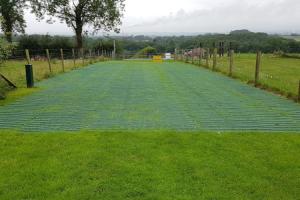Outdoor ground protection system for historic places
The new ground protection system at Tullaghoge Fort was chosen as it allows for the least potential harm to buried archaeological remains and it’s for fairly level areas with moderate footfall. It can be removed without harm to the site. It’s low cost and will last several decades.
How it functions

The site conditions at Tullaghoge Fort (near Cookstown in Northern Ireland) have lent themselves to this particular ground protection solution as it’s for reasonably level sites and prevents compaction of the underlying ground surface. This ground protection system (plastic meshing) also provides improved traction and slip resistance when compared with other meshing. The grass will grow through the mesh and entwine over the mats over time to provide long lasting ground protection against wear with minimal visual impact. It does mean that the area of the path surface is now laced with metal staples, so the scope for some archaeological surveys in this area will now be limited.
Management
This ground protection system changes how that particular portion of the site is managed in the long term:

- you can’t have heavy machinery, such as tractors on the plastic mesh as it would cut it up and/ or churn it up, defeating the purpose of the work and presenting a significant hazard to people and livestock
- some machinery, in the right weather and under supervision may be fine, such as mowers and other small agricultural vehicles
- to access the interior of the site for further works to do with the trees, and heavier machinery is needed, then you need to protect the mesh by placing heavy mats on top that are appropriate to the weather conditions. This isn’t something that we would expect to have to do frequently but it needed to be thought about for the future.
- Once the grass is established it will be possible to mow it but on a high setting and with good blades. It is something that would need to be brought to the attention of the grounds maintenance contractor, as well as the staff on the site.
- As part of the routine site inspections staff will need to note if any of the metal staples have risen out of the ground surface. This will be important to ensure that the mesh beds down, that the staples don’t become a trip or machine hazard, and to avoid displacing the mesh on the ground.
All in it’s a good demonstration of the conservation principles for site management, and once it’s bedded in, it should last for several decades.
Other useful links
Follow us on Love Heritage NI Facebook, Twitter and Instagram
